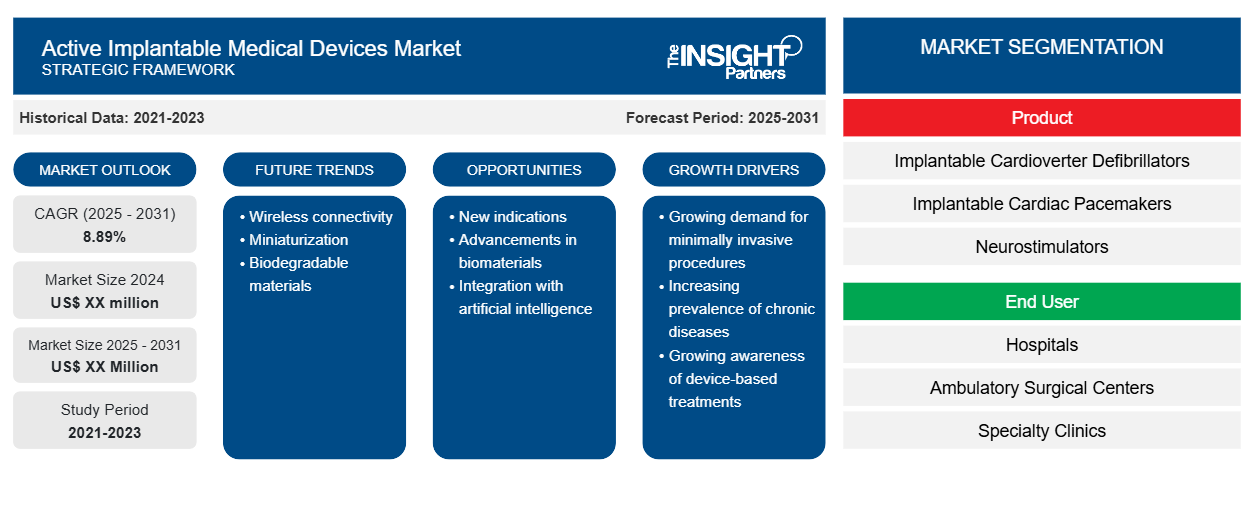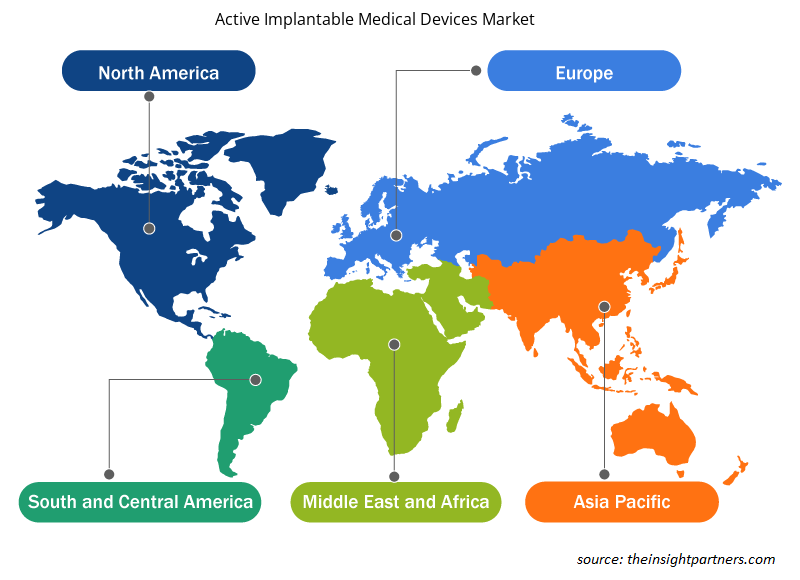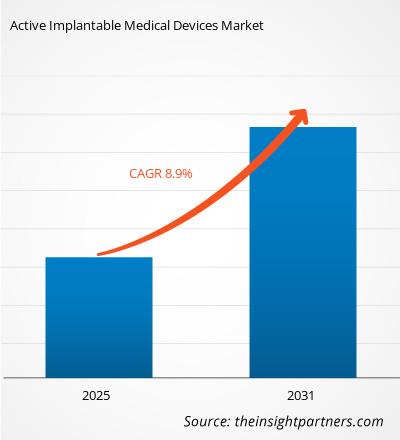The Active Implantable Medical Devices Market is expected to register a CAGR of 8.89% from 2025 to 2031, with a market size expanding from US$ XX million in 2024 to US$ XX Million by 2031.
The report is segmented by Product [Implantable Cardioverter Defibrillators (Transvenous Implantable Cardioverter Defibrillators and Subcutaneous Implantable Cardioverter Defibrillators), Implantable Cardiac Pacemakers, Neurostimulators, Implantable Hearing Devices, Ventricular Assist Devices, and Implantable Heart Monitors/ Insertable Loop Recorders], and End User (Hospitals, Ambulatory Surgical Centers, and Specialty Clinics). The global analysis is further broken-down at regional level and major countries. The Report Offers the Value in USD for the above analysis and segments.
Purpose of the Report
The report Active Implantable Medical Devices Market by The Insight Partners aims to describe the present landscape and future growth, top driving factors, challenges, and opportunities. This will provide insights to various business stakeholders, such as:
- Technology Providers/Manufacturers: To understand the evolving market dynamics and know the potential growth opportunities, enabling them to make informed strategic decisions.
- Investors: To conduct a comprehensive trend analysis regarding the market growth rate, market financial projections, and opportunities that exist across the value chain.
- Regulatory bodies: To regulate policies and police activities in the market with the aim of minimizing abuse, preserving investor trust and confidence, and upholding the integrity and stability of the market.
Active Implantable Medical Devices Market Segmentation
Product
- Implantable Cardioverter Defibrillators
- Implantable Cardiac Pacemakers
- Neurostimulators
- Implantable Hearing Devices
- Ventricular Assist Devices
- Implantable Heart Monitors/ Insertable Loop Recorders
End User
- Hospitals
- Ambulatory Surgical Centers
- Specialty Clinics
You will get customization on any report - free of charge - including parts of this report, or country-level analysis, Excel Data pack, as well as avail great offers and discounts for start-ups & universities
Active Implantable Medical Devices Market: Strategic Insights

- Get Top Key Market Trends of this report.This FREE sample will include data analysis, ranging from market trends to estimates and forecasts.
Active Implantable Medical Devices Market Growth Drivers
- Growing demand for minimally invasive procedures : Active implantable devices such as pacemakers, implantable cardioverter-defibrillators (ICDs), and neurostimulators are designed to provide minimally invasive treatment options for patients.
- Increasing prevalence of chronic diseases : The rising incidence of chronic diseases such as diabetes, hypertension, and neurological disorders is driving the demand for active implantable devices.
- Growing awareness of device-based treatments : Healthcare providers and patients are increasingly recognizing the benefits of device-based treatments, which are often more effective and cost-effective than traditional pharmaceutical therapies.
Active Implantable Medical Devices Market Future Trends
- Wireless connectivity : The trend towards wireless connectivity is enabling remote monitoring and control of active implantable devices, improving patient outcomes and reducing healthcare costs.
- Miniaturization : The development of smaller, more compact devices is enabling implantation at multiple sites, improving patient comfort and reducing surgical risks.
- Biodegradable materials : The use of biodegradable materials is reducing the risk of device-related complications and enabling the development of more complex implants.
Active Implantable Medical Devices Market Opportunities
- New indications : The discovery of new therapeutic indications for active implantable devices is expected to drive growth in the market
- Advancements in biomaterials : The development of new biomaterials with improved biocompatibility, durability, and functionality is expected to enable the creation of more sophisticated active implantable devices.
- Integration with artificial intelligence : The integration of artificial intelligence (AI) with active implantable devices is expected to improve diagnostic accuracy, treatment outcomes, and patient engagement.
Active Implantable Medical Devices Market Regional Insights
The regional trends and factors influencing the Active Implantable Medical Devices Market throughout the forecast period have been thoroughly explained by the analysts at Insight Partners. This section also discusses Active Implantable Medical Devices Market segments and geography across North America, Europe, Asia Pacific, Middle East and Africa, and South and Central America.

- Get the Regional Specific Data for Active Implantable Medical Devices Market
Active Implantable Medical Devices Market Report Scope
| Report Attribute | Details |
|---|---|
| Market size in 2024 | US$ XX million |
| Market Size by 2031 | US$ XX Million |
| Global CAGR (2025 - 2031) | 8.89% |
| Historical Data | 2021-2023 |
| Forecast period | 2025-2031 |
| Segments Covered |
By Product
|
| Regions and Countries Covered | North America
|
| Market leaders and key company profiles |
Active Implantable Medical Devices Market Players Density: Understanding Its Impact on Business Dynamics
The Active Implantable Medical Devices Market is growing rapidly, driven by increasing end-user demand due to factors such as evolving consumer preferences, technological advancements, and greater awareness of the product's benefits. As demand rises, businesses are expanding their offerings, innovating to meet consumer needs, and capitalizing on emerging trends, which further fuels market growth.
Market players density refers to the distribution of firms or companies operating within a particular market or industry. It indicates how many competitors (market players) are present in a given market space relative to its size or total market value.
Major Companies operating in the Active Implantable Medical Devices Market are:
- Medtronic
- ABBOTT
- Cochlear Ltd.
- Boston Scientific Corporation
- BIOTRONIK
Disclaimer: The companies listed above are not ranked in any particular order.

- Get the Active Implantable Medical Devices Market top key players overview
Key Selling Points
- Comprehensive Coverage: The report comprehensively covers the analysis of products, services, types, and end users of the Active Implantable Medical Devices Market, providing a holistic landscape.
- Expert Analysis: The report is compiled based on the in-depth understanding of industry experts and analysts.
- Up-to-date Information: The report assures business relevance due to its coverage of recent information and data trends.
- Customization Options: This report can be customized to cater to specific client requirements and suit the business strategies aptly.
The research report on the Active Implantable Medical Devices Market can, therefore, help spearhead the trail of decoding and understanding the industry scenario and growth prospects. Although there can be a few valid concerns, the overall benefits of this report tend to outweigh the disadvantages.
Frequently Asked Questions
What is the expected CAGR of the active implantable medical devices market?
The active implantable medical devices market is estimated to grow with a CAGR of 8.8% from 2023 to 2031.
Which region is expected to witness fastest growth rate by 2031?
Asia Pacific region is likely to witness fastest growth rate during the forecast period.
What are the driving factors impacting the active implantable medical devices market?
The market drivers include increasing prevalence of dental diseases and advancements in dental technologies are driving the active implantable medical devices market
Which are the leading players operating in the active implantable medical devices market?
The active implantable medical devices market majorly consists of the players such as Medtronic, ABBOTT, Cochlear Ltd, Boston Scientific Corporation among others.
What are the future trends of the active implantable medical devices market?
Biodegradable materials is likely to remain the key trend during the forecast period
Which region dominated the active implantable medical devices market in 2023?
North America dominated the active implantable medical devices market in 2023
- Historical Analysis (2 Years), Base Year, Forecast (7 Years) with CAGR
- PEST and SWOT Analysis
- Market Size Value / Volume - Global, Regional, Country
- Industry and Competitive Landscape
- Excel Dataset
Testimonials
I wish to appreciate your support and the professionalism you displayed in the course of attending to my request for information regarding to infectious disease IVD market in Nigeria. I appreciate your patience, your guidance, and the fact that you were willing to offer a discount, which eventually made it possible for us to close a deal. I look forward to engaging The Insight Partners in the future, all thanks to the impression you have created in me as a result of this first encounter.
DR CHIJIOKE ONYIA, MANAGING DIRECTOR, PineCrest Healthcare Ltd.The Insight Partners delivered insightful, well-structured market research with strong domain expertise. Their team was professional and responsive throughout. The user-friendly website made accessing industry reports seamless. We highly recommend them for reliable, high-quality research services
Yukihiko Adachi CEO, Deep Blue, LLC.Reason to Buy
- Informed Decision-Making
- Understanding Market Dynamics
- Competitive Analysis
- Customer Insights
- Market Forecasts
- Risk Mitigation
- Strategic Planning
- Investment Justification
- Identifying Emerging Markets
- Enhancing Marketing Strategies
- Boosting Operational Efficiency
- Tracking Industry Innovations
- Aligning with Regulatory Trends
Yes! We provide a free sample of the report, which includes Report Scope (Table of Contents), report structure, and selected insights to help you assess the value of the full report. Please click on the "Download Sample" button or contact us to receive your copy.
Absolutely — analyst assistance is part of the package. You can connect with our analyst post-purchase to clarify report insights, methodology or discuss how the findings apply to your business needs.
Once your order is successfully placed, you will receive a confirmation email along with your invoice.
• For published reports: You’ll receive access to the report within 4–6 working hours via a secured email sent to your email.
• For upcoming reports: Your order will be recorded as a pre-booking. Our team will share the estimated release date and keep you informed of any updates. As soon as the report is published, it will be delivered to your registered email.
We offer customization options to align the report with your specific objectives. Whether you need deeper insights into a particular region, industry segment, competitor analysis, or data cut, our research team can tailor the report accordingly. Please share your requirements with us, and we’ll be happy to provide a customized proposal or scope.
The report is available in either PDF format or as an Excel dataset, depending on the license you choose.
The PDF version provides the full analysis and visuals in a ready-to-read format. The Excel dataset includes all underlying data tables for easy manipulation and further analysis.
Please review the license options at checkout or contact us to confirm which formats are included with your purchase.
Our payment process is fully secure and PCI-DSS compliant.
We use trusted and encrypted payment gateways to ensure that all transactions are protected with industry-standard SSL encryption. Your payment details are never stored on our servers and are handled securely by certified third-party processors.
You can make your purchase with confidence, knowing your personal and financial information is safe with us.
Yes, we do offer special pricing for bulk purchases.
If you're interested in purchasing multiple reports, we’re happy to provide a customized bundle offer or volume-based discount tailored to your needs. Please contact our sales team with the list of reports you’re considering, and we’ll share a personalized quote.
Yes, absolutely.
Our team is available to help you make an informed decision. Whether you have questions about the report’s scope, methodology, customization options, or which license suits you best, we’re here to assist. Please reach out to us at sales@theinsightpartners.com, and one of our representatives will get in touch promptly.
Yes, a billing invoice will be automatically generated and sent to your registered email upon successful completion of your purchase.
If you need the invoice in a specific format or require additional details (such as company name, GST, or VAT information), feel free to contact us, and we’ll be happy to assist.
Yes, certainly.
If you encounter any difficulties accessing or receiving your report, our support team is ready to assist you. Simply reach out to us via email or live chat with your order information, and we’ll ensure the issue is resolved quickly so you can access your report without interruption.















The List of Companies - Active Implantable Medical Devices Market
- Medtronic
- ABBOTT
- Cochlear Ltd.
- Boston Scientific Corporation
- BIOTRONIK
- MED-EL
- SONOVA
- William Demant Holding A/S
- LivaNova PLC
- Nurotron Biotechnology Co. Ltd.






 Get Free Sample For
Get Free Sample For